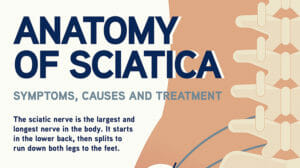Anatomy of Sciatica
Symptoms, Causes and Treatment
The sciatic nerve is the largest and longest nerve in the body. It starts in the lower back, then splits to run down both legs to the feet.
It provides motor control and sensation to the majority of the lower legs and feet.
Sciatica is often confused with general lower back pain, but it is a specific condition effecting the sciatic nerve.
It can interfere with daily function and be debilitating until resolved. Sciatic pain increases with flexing, twisting, and bending motions.
Between 10 and 40% of Americans will experience sciatic nerve pain at some point in their lives. (1)
1. https://www.ncbi.nlm.nih.gov/books/NBK507908/
Symptoms of Sciatica
The most common symptom of sciatica is lower back pain that extends through the hip and buttock and down one leg.
This pain is generally shooting and can make it difficult to sit.
Other symptoms:
Numbness or weakness in the leg
Burning or tingling feeling in the leg
Symptoms can be sudden or develop gradually over time
2. https://jamanetwork.com/journals/jama/fullarticle/184229
Sciatica Causes
Causes of sciatica include: (3)
– Ruptured, or herniated, intervertebral disc
– The jelly-like center of the disk leaks and irritates or compresses nerves in the lower back, or even the sciatic nerve itself.
– Spinal stenosis, the narrowing of the spinal canal
– This can put pressure on nerves exiting the spinal canal.
– Pelvic fracture or other trauma
– Nervous tissue can be effected by injuries of this sort.
3. https://medlineplus.gov/sciatica.html
There are also a number of factors that put you at risk for sciatica:
Age
The condition primarily impacts people in their 40s. Changes in the spine related to aging include herniated disks and bone spurs — both of which can cause sciatica. (2,4)
Weight
Excess bodyweight creates additional stress on the spine and can contribute to sciatica (4)
Sedentary behavior, particularly prolonged sitting
Sitting for long periods of time compresses and can herniate spinal discs (1)
Sleeping on a mattress that’s too hard OR too soft
About third of our time is spent sleeping, and the wrong mattresses can contribute to sciatica pain (5)
2. https://jamanetwork.com/journals/jama/fullarticle/184229
4. https://www.mayoclinic.org/diseases-conditions/sciatica/symptoms-causes/syc-20377435
5. https://www.webmd.com/back-pain/guide/sciatica-symptoms
1. https://www.ncbi.nlm.nih.gov/pmc/articles/PMC2200681/
Treatment for Sciatica
Approximately 80% to 90% of people with sciatica recover without any surgical intervention. (2)
2. https://jamanetwork.com/journals/jama/fullarticle/184229
Treatments and therapies for sciatica: (1,2)
– Daily stretching and strengthening exercise
– Heat and/or cold packs
– Analgesics for pain and inflammation
– Steroids
– Physical therapy
– Supportive and ergonomic chairs
– Rest, on a supportive mattress
– Surgical intervention
Additional Resources on Sciatic Pain
Best Mattresses for People with Sciatic Pain
How to Treat Sciatic Pain During Sleep
What Causes Sciatic Nerve Pain?
1. https://www.ncbi.nlm.nih.gov/books/NBK507908/
2. https://jamanetwork.com/journals/jama/fullarticle/184229
SOURCES:
ncbi.nlm.nih.gov
jamanetwork.com
medlineplus.gov
mayoclinic.org
webmd.com

